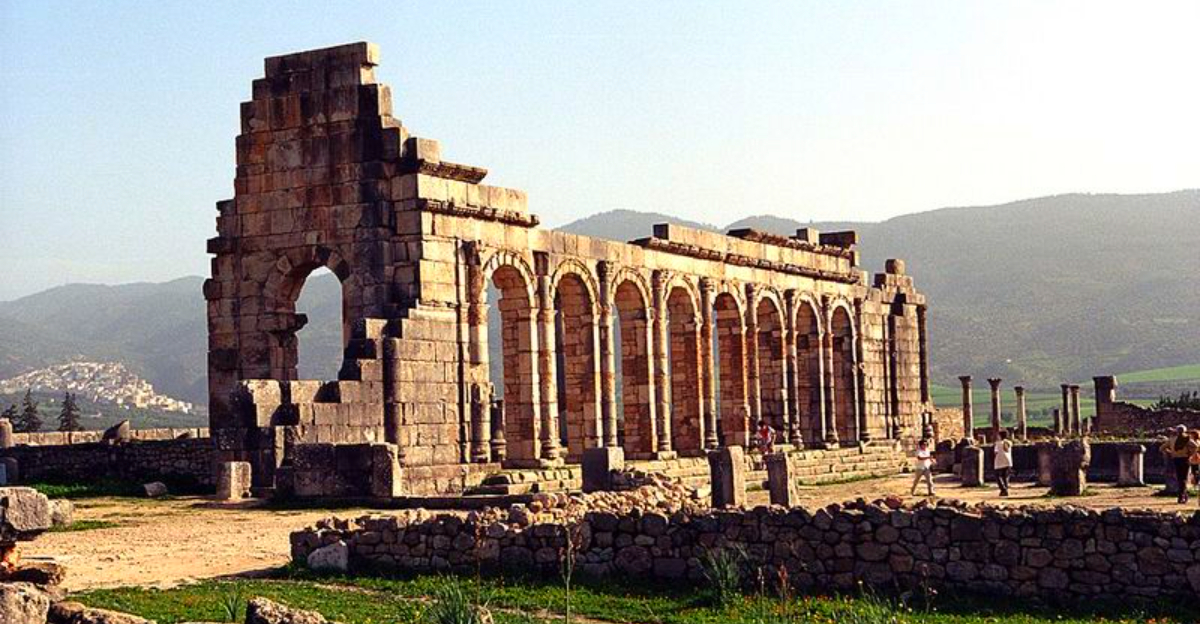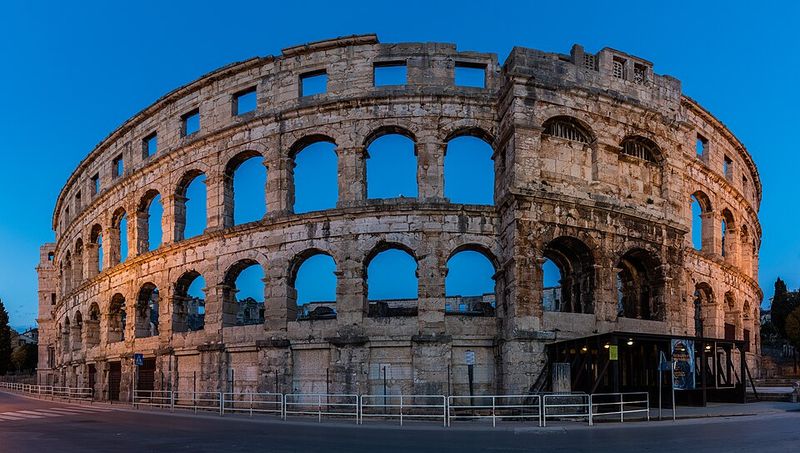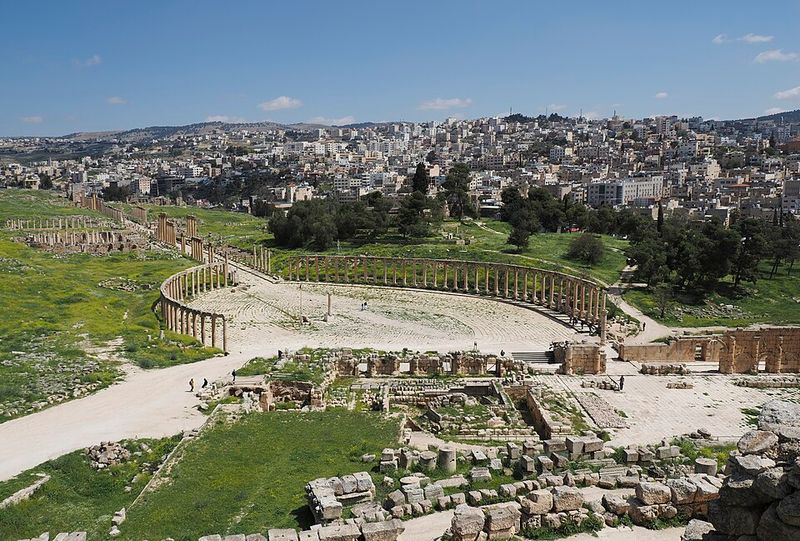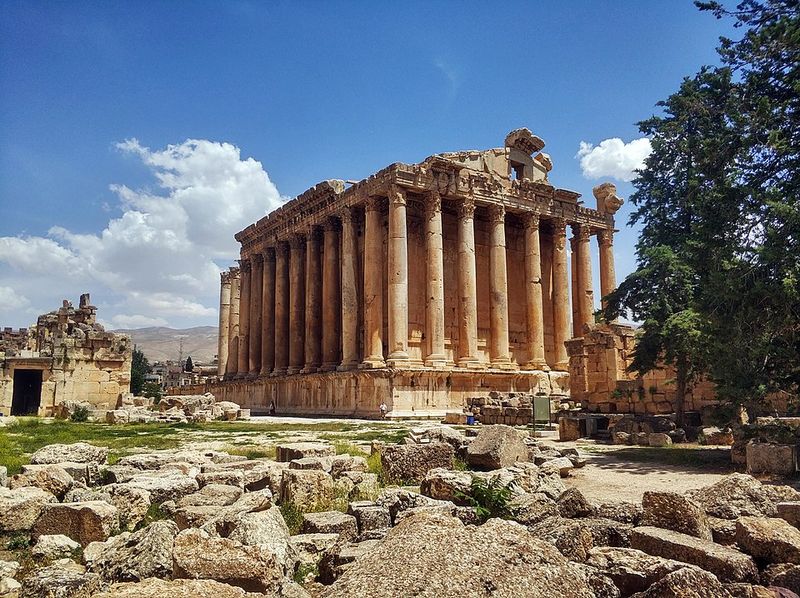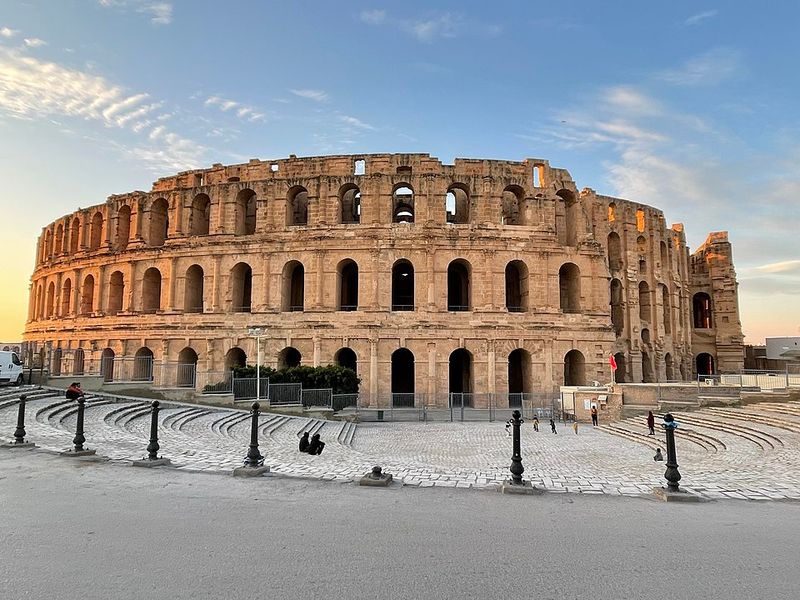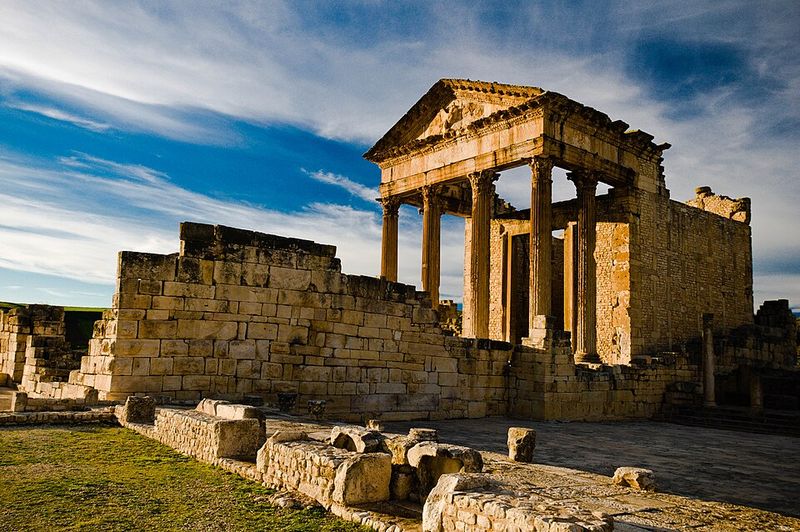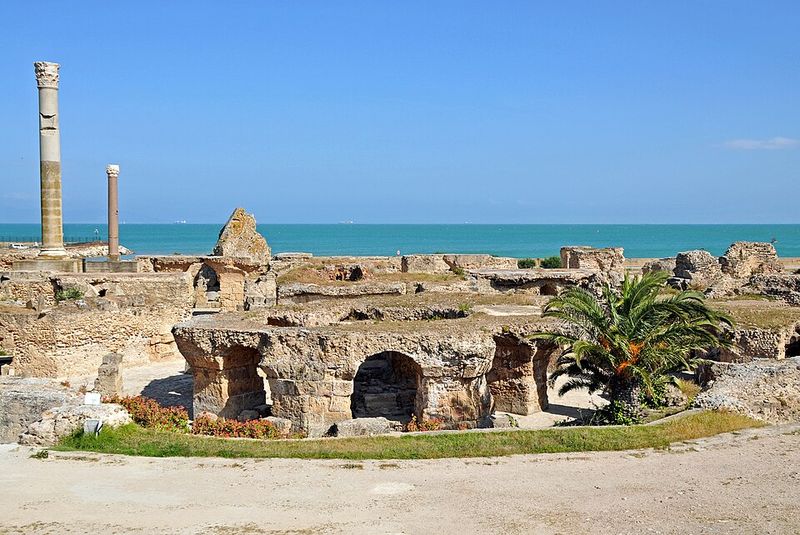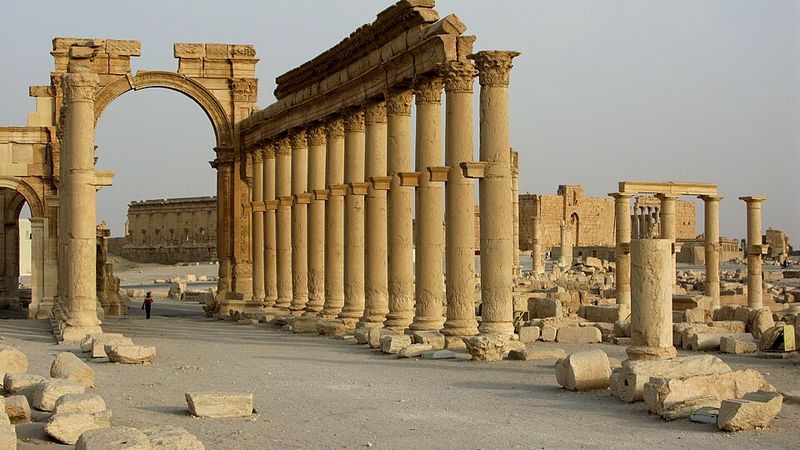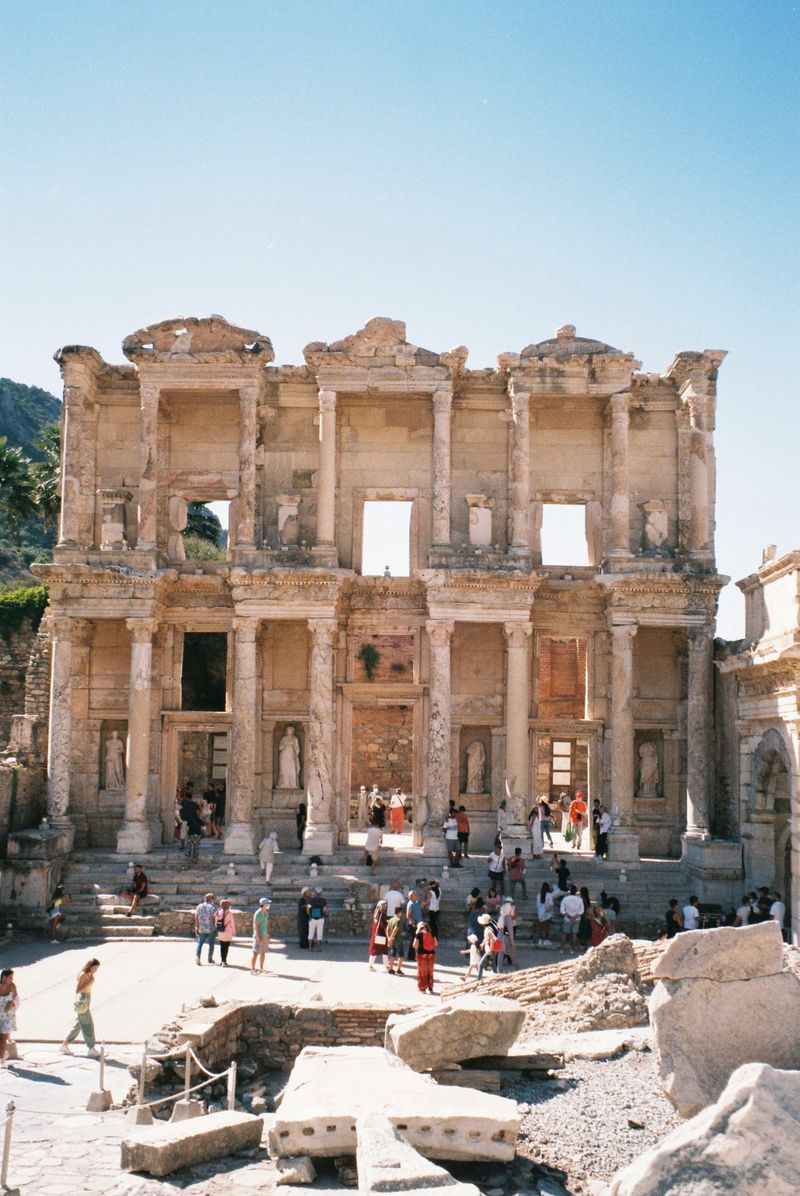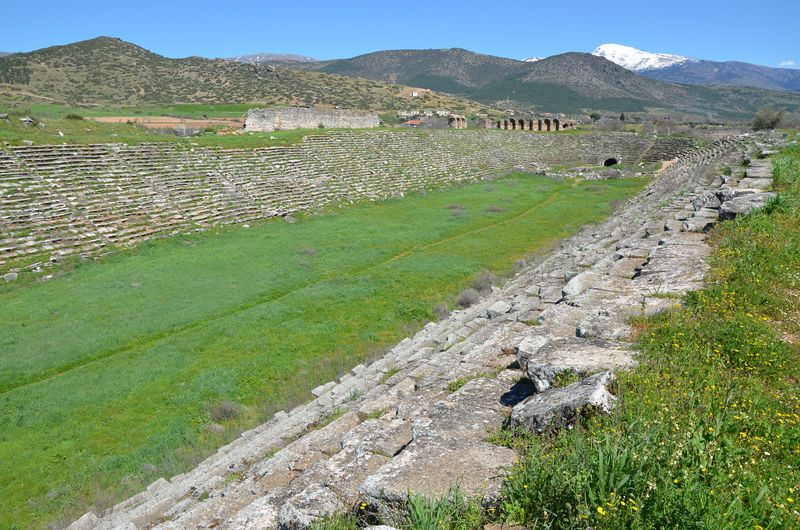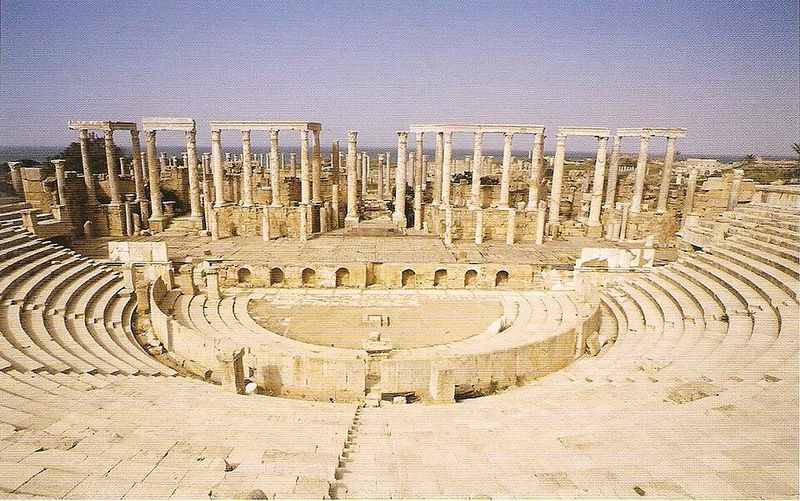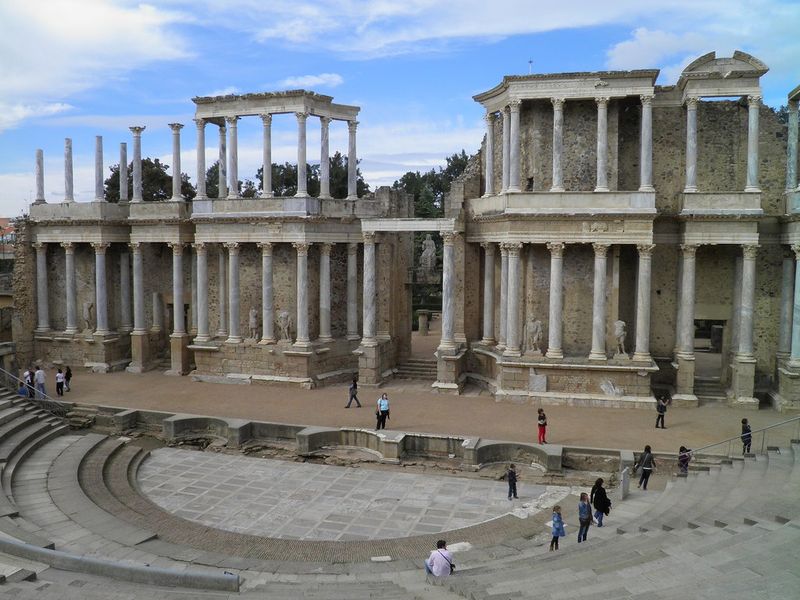Across continents, the Roman Empire stamped cities, roads, and monuments that still command awe. Beyond Italy, its legacy unfolds in aqueducts, amphitheaters, palaces, and entire city grids preserved in stone. These sites reveal engineering brilliance, imperial ambition, and everyday life with astonishing clarity. Prepare to travel from North Africa to the Levant and deep into Europe to meet the empire at its most breathtaking.
1. Pont du Gard – France
Pont du Gard rises above the Gardon River as a masterclass in Roman engineering elegance. Built in the 1st century AD, its triple tiers of arches delivered water to Nemausus with astonishing precision. The golden limestone glows at sunset, revealing meticulous masonry that required no mortar. Despite centuries of floods and wars, the structure endures with remarkable integrity. Walkways and viewpoints let visitors appreciate both its scale and natural setting. Interpretive displays explain hydraulic gradients and construction techniques. The aqueduct’s harmony of function and beauty earns its iconic status. Few monuments better embody Rome’s practical genius and artistic restraint.
2. Amphitheatre of Pula – Croatia
The Amphitheatre of Pula dominates Croatia’s Istrian coast with a silhouette nearly intact since the 1st century. Built of pale limestone, its outer arcades and four corner towers showcase refined Roman design. Once hosting gladiatorial spectacles, it now stages concerts, echoing with history and sound. Informational exhibits reveal arena mechanics, including cages and corridors. The structure’s robustness speaks to Roman mastery of load distribution and stone fitting. Views from the upper tiers frame the Adriatic, adding maritime grandeur. Its scale rivals Italy’s greatest amphitheaters. Pula’s arena proves that provincial cities also received imperial-level architecture and ambition.
3. Hadrian’s Wall – United Kingdom
Hadrian’s Wall spans northern England in a bold line of stone and turf that once defined Rome’s frontier. Built in the early 2nd century under Emperor Hadrian, it combined forts, milecastles, and turrets with a service road. The wall’s course over rugged ridges is spectacular, especially near Housesteads and Steel Rigg. Museums and reconstructions interpret garrisons’ daily routines, supply chains, and cultural mixing. While not fully continuous today, its surviving stretches evoke imperial control at the edge of the world. Walkers follow the National Trail across moorland panoramas. It remains a powerful testament to frontier logistics and authority.
4. Jerash (Gerasa) – Jordan
Jerash unfurls a near-complete Roman cityscape, revealing urban life with theatrical flair. Enter through the monumental Hadrian’s Arch and step into the Oval Plaza, ringed by elegant columns. The colonnaded Cardo leads to temples, nymphaea, and two theatres with excellent acoustics. Mosaics and inscriptions illuminate civic pride and religious diversity. Earthquakes and sands preserved much of the layout, later excavations exposing streets, shops, and baths. The site’s coherence makes navigation intuitive, offering line-of-sight vistas between key monuments. Seasonal festivals reanimate spaces. Jerash’s blend of preservation and scale makes it one of the most immersive Roman experiences anywhere.
5. Baalbek – Lebanon
Baalbek astonishes with columns that seem to defy proportion and gravity. The Temple of Jupiter once boasted some of the largest columns in the Roman world, while the Temple of Bacchus survives with lavish carvings intact. Gigantic foundation blocks hint at earlier megalithic traditions repurposed by Roman engineers. Reliefs, staircases, and courtyards invite close study of sculptural mastery. Despite historical upheavals, the complex remains remarkably impressive. On-site museums contextualize the city’s role in trade and religion. Sunlight plays across honeyed stone, sharpening shadows and detail. Baalbek encapsulates imperial grandeur raised from local stone and monumental ambition.
6. El Djem Amphitheatre – Tunisia
El Djem’s colossal amphitheatre rises from the Tunisian plain like a sand-colored crown. Built in the 3rd century, it rivals Rome’s Colosseum in size and preservation. Visitors can roam underground passages, imagining gladiators awaiting the roar of the crowd. The arena’s geometry reveals careful calculations for sightlines and circulation. Upper tiers deliver sweeping views over olive groves. Interpretive plaques illuminate construction techniques and the city’s economic life. Its endurance through centuries of reuse underscores resilient engineering. El Djem stands as North Africa’s most commanding Roman arena, where silence now replaces the ancient frenzy of spectacle.
7. Dougga (Thugga) – Tunisia
Dougga crowns a hillside with a textbook Roman city plan preserved in tranquil countryside. The Capitol’s towering portico dominates, while the theatre offers hillside seating with expansive vistas. Streets thread between houses, temples, and public buildings, each telling civic stories. Latin inscriptions and Punic remnants reveal cultural blending. The site’s isolation spared it from heavy quarrying, leaving streetscapes remarkably intact. You can wander alleys, courtyards, and sanctuaries with little modern intrusion. Seasonal wildflowers soften stone edges, enhancing the romantic ambiance. Dougga’s completeness makes it a rare place to grasp provincial urban life in three dimensions.
8. Baths of Antoninus (Carthage) – Tunisia
The Baths of Antoninus at Carthage showcase Roman indulgence scaled to an imperial port. As the largest bath complex outside Italy, they once featured hot and cold rooms, natatio pools, and soaring vaults. Today, evocative substructures and fragments outline the massive footprint. Models and signage help visualize the missing superstructure. The Mediterranean glimmers nearby, hinting at the city’s maritime power. Thermal engineering shines in hypocaust pillars and channel remains. Even in ruins, the baths suggest bustling routines of exercise, gossip, and politics. Their size and setting convey Carthage’s importance within Roman Africa’s network of prosperous cities.
9. Trier Roman Monuments – Germany
Trier threads Roman grandeur through a living German city. The Porta Nigra looms as a fortified gate of dark stone, while Constantine’s Basilica dwarfs with its cavernous brick hall. The Imperial Baths and amphitheater round out a civic ensemble fit for an imperial residence. Museums display mosaics, inscriptions, and luxury goods from a northern capital. Walking routes link sites efficiently, revealing urban continuity across millennia. The preservation varies yet collectively impresses with breadth and depth. Trier’s monuments illustrate how Rome adapted architecture to local materials and climate. It remains a vital window into imperial administration beyond Italy.
10. Conimbriga – Portugal
Conimbriga preserves lavish villas where mosaics shimmer with Roman artistry. Peristyle courtyards, fountains, and heated rooms reveal domestic luxury on the empire’s Atlantic edge. Street grids and defensive walls trace the town’s evolution through prosperity and threat. On-site signage clarifies plumbing systems and mosaic iconography. The museum displays finely crafted artifacts that contextualize daily life and trade. Protective shelters allow close viewing of floors without damage. Even partially ruined, rooms read clearly as lived spaces. Conimbriga’s intimacy contrasts with monumental sites, offering a personal view of wealth, taste, and technological comfort in Roman Iberia.
11. Volubilis – Morocco
Volubilis spreads across a fertile plateau, its arches and basilica framed by olive trees. The Arch of Caracalla anchors a cityscape rich in mosaicked villas depicting myths and daily scenes. Workshops and olive presses reveal economic engines beyond grand facades. The site’s openness invites wandering among columns and courtyards. Inscriptions and Latin graffiti whisper civic identities on Africa’s edge. The nearby museum complements on-site interpretation. Sunset transforms the stone into amber tones, intensifying textures. Volubilis balances grandeur with agricultural context, illustrating how Rome harnessed North Africa’s productivity while exporting architecture and administrative order.
12. Palmyra – Syria
Palmyra’s colonnades once guided caravans through a cosmopolitan desert metropolis. Roman architectural language mingled with local styles, producing grand avenues, temples, and a theater with distinctive ornament. While recent conflicts damaged sections, the surviving structures retain haunting beauty and historical gravity. Archival photos and digital reconstructions help visualize lost elements. The site symbolizes both cultural exchange and vulnerability. Scholars continue to assess conservation strategies balancing authenticity and recovery. Palmyra’s setting, light, and long trade history still captivate the imagination. Its story urges global commitment to protecting shared heritage across borders and generations.
13. Ephesus – Turkey
Ephesus unfolds as a marble city where civic life converged in spectacle and learning. The Library of Celsus dazzles with a sculpted facade, while the Great Theatre once echoed with tens of thousands of voices. Curetes Street links fountains, temples, and shops in polished stone. Excavations reveal terraced houses with frescoes and intricate heating systems. The harbor’s silted retreat rewrote the city’s destiny, preserved in layers of urban change. Signage and museums provide context without overwhelming. Early morning light heightens textures and serenity. Ephesus remains one of the world’s most complete studies in Roman urban grandeur.
14. Aphrodisias – Turkey
Aphrodisias marries athletic spectacle with sculptural excellence. Its elongated stadium is among the best preserved, mirroring the city’s passion for public games. The Tetrapylon and theater highlight refined marble craftsmanship from renowned local quarries. Workshops and inscriptions document a thriving sculptors’ school influencing art across the empire. The museum’s portrait gallery is exceptional, illuminating imperial propaganda and local identity. Footpaths connect monuments in a tranquil landscape. Carvings retain crisp detail that rewards close inspection. Aphrodisias offers a rare fusion of artistic production site and civic architecture, revealing how stone shaped culture as much as structures.
15. Bulla Regia – Tunisia
Bulla Regia adapts to climate with subterranean villas that stay cool under North African sun. House plans place richly mosaicked rooms below ground level, connected by stairways and courtyards. The architecture shows innovation driven by environment, without sacrificing luxury. Columns, baths, and public buildings complement domestic spaces. Guides help decode unusual layouts and ventilation methods. The sense of discovery is strong as you descend into preserved chambers. Mosaics depicting nature and myth remain vivid. Bulla Regia challenges assumptions about Roman standardization, proving provincial creativity thrived within imperial frameworks.
16. Leptis Magna – Libya
Leptis Magna presents an astonishingly complete Roman metropolis etched into Libya’s coast. The Severan Basilica’s soaring columns, the forum’s orderly spaces, and the theatre’s sea breezes evoke a living city. Streets connect markets, baths, and a harbor engineered for Mediterranean trade. Carvings and inscriptions celebrate local son Emperor Septimius Severus. Sand cover preserved details that excavations have revealed with clarity. The site’s scale allows hours of exploration without repetition. Despite logistical challenges, it remains a pinnacle of urban preservation. Leptis Magna embodies Roman planning at full expression, balanced between grandeur and practical maritime commerce.
17. Caesarea Maritima – Israel
Caesarea Maritima aligns Roman urbanism with Herodian audacity on the Mediterranean shore. The theater and hippodrome front the sea, while the aqueduct strides elegantly across the sand. Underwater remains and harbor works attest to pioneering concrete engineering. The promenade connects ruins with modern amenities and a museum. Inscriptions and sculptures underscore the city’s multicultural life and later Byzantine layers. Waves and wind animate the scenery, giving stone a dynamic frame. The site offers both leisurely strolls and deep historical dives. Caesarea’s marriage of spectacle and seafaring technology made it a vital coastal hub.
18. Timgad – Algeria
Timgad is a Roman blueprint rendered in stone and sunshine. Founded by Trajan, its orthogonal grid remains strikingly legible from ground and air. The Decumanus and Cardo intersect near the forum, where arches and inscriptions frame civic life. Homes, baths, and a theater reveal everyday rhythms of a planned colony. Sand preserved pavements and thresholds with crisp edges. The site’s clarity makes urban design principles immediately graspable. Excellent signage aids orientation and interpretation. Timgad is both archaeological treasure and a living lesson in Roman town planning’s logic, efficiency, and aesthetic order.
19. Mérida (Emerita Augusta) – Spain
Mérida offers a concentrated feast of Roman monuments embedded in a vibrant Spanish city. The theater’s reconstructed scaenae frons restores classical drama’s architectural backdrop. Adjacent, the amphitheatre completes a paired entertainment district. The aqueduct of Los Milagros strides across a valley, while temples and a bridge underline infrastructural prowess. Museums house mosaics and epigraphy that enrich the narrative. Signposted walking circuits connect sites efficiently. Performances still enliven the theater in summer. Mérida’s density and variety make it a premier destination for understanding how Roman culture endured and evolved in the Iberian Peninsula.
20. Split (Diocletian’s Palace) – Croatia
Diocletian’s Palace in Split transforms a late Roman imperial residence into a living urban core. The Peristyle thrums with life beneath colonnades that once framed imperial ceremonies. Substructures, temples, and gates blend with medieval and modern layers, creating a rare continuous city fabric. Stone sphinxes and reused capitals add eclectic charm. Wayfinding reveals a palace that became a town, then a city. Museums and cellars interpret the transition from empire to Byzantium and beyond. Cafes and homes inhabit ancient walls, making history tangible. Split exemplifies adaptive reuse across seventeen centuries of daily life.
